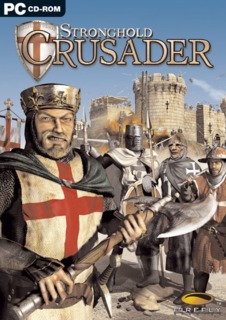INTRO:
Historical wars make for very good settings for real-time strategy games, as can be seen in the Age of Empires series.
Not to miss out on the trend during the turn of the previous millennium, Firefly Studios created the Stronghold series, initially with the intent of exploiting the wars in the medieval age of Europe.
Later, Firefly Studios went on to exploit the Crusades, by creating a spin-off series which is called – unsurprisingly – Stronghold Crusaders.
A decade after the debut of the spin-off, Firefly Studios decided that it should jump on another fad band-wagon: re-releasing old games with spruced-up graphics and slapping the label “HD” on them.
Perhaps what has been said so far here is a tad too cynical, but once one plays the game, he/she would understand.

PREMISE:
As mentioned earlier, Stronghold Crusaders – and its HD version - is based on the Crusades. It includes portrayals of the conflicts of this era, though “portrayals” is perhaps a word which the game does not deserve because of the liberties which the game takes.
In addition to the obvious conflicts between the Crusaders and the Middle Easterners, there are the conflicts which arose from the collapse of the Crusades as well as so many attempts by petty lords to grab power in the Holy Land for themselves.
Of course, not all of the events which are mentioned in the game are real at all. At the very least, the game is more-or-less up-front in mentioning that it is not historically accurate.
Still, it has to be said here that if the player is looking for a game which has a more faithful take on the Crusades (pun very much intended), he/she can do better than Stronghold Crusader HD.
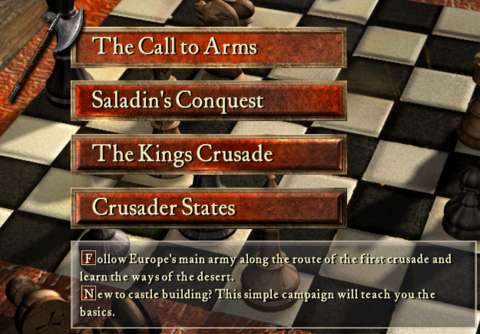
MANUAL:
As to be expected, most of what the player needs to know in order to play the game is in the manual. This includes the mappings for keyboard shortcuts, which, unfortunately, cannot be changed in-game. (Some of these are broken too; this will be described later.)
If the player is playing Stronghold Crusader through the “Extreme” package, the manual is distributed in the form of a rather sloppily-done scan. There are quite a number of typos in the manual.
For the most part, the manual is serious and to the point about the gameplay of Stronghold Crusader. However, there is some amusing (and hardly gameplay-related) writing to be had in the section about “non-military” characters (of which the lord is considered to be one, oddly enough).
GAMEPLAY – FOREWORDS:
As is typical of a game in the real-time strategy (RTS) genre during the first decade of the 21st century, Stronghold Crusader has the player building what is essentially a base or town (to cite the genre’s tropes) and using this to raise an army to crush enemies with.
However, the Stronghold series was notable for turning some gameplay tropes about the genre on their heads. Stronghold Crusader is no different, though some of the metaphorical magic has perhaps dissipated by the time this spin-off debuted.
KEEP & LORD:
The headquarters of the player’s base is the keep. It can take a few forms, but it is usually the most imposing structure in the player’s base – barring any walls or towers which the player raises for defence. The keep is used for making many important decisions, such as setting taxes, and it is where peasants come out from.
The keep is actually indestructible, so it is not the player’s greatest vulnerability. Instead, that would be an actual unit, which is the lord.
The player’s lord is an exaggeratedly hulking and grandiose-looking bloke. In the campaign mode, he has his own mind, milling around looking important but doing next to nothing. This can be a problem; he can wander off somewhere inconvenient, making him vulnerable.
Fortunately, he only wanders a certain distance from the keep; this distance can be used to gauge where best to place walls to protect him in campaign scenarios.
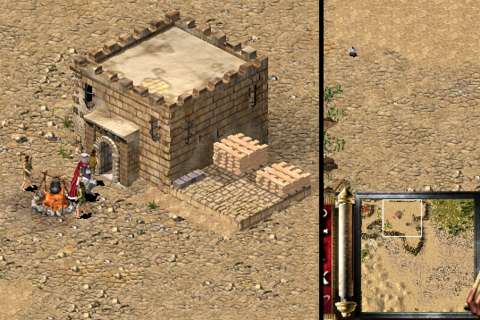
Fortunately, the lord is not a slouch at combat and is not entirely stupid. When enemies are afoot in campaign scenarios, the lord draws his weapon and returns to the keep, ready to defend himself.
In other game modes, the lord is practically a powerhouse unit which can be used for some very risky tactics, such as early-match defence before the player has raised sizable armies and can have him retreating back to his keep.
PEASANTS:
Peasants are the “units” which the player needs in order to work his/her economy. Peasants are also the “resource” which is consumed (albeit temporarily) when the player recruits military units.
(History buffs may be aghast as to how these seeming peons can somehow be turned into knights and other elite soldiers of the medieval era, or even change gender. Of course, this is just a computer game.)
Anyway, peasants are ostensibly attracted to the player’s service through his/her popularity. Higher popularity results in quicker replenishment of the stock of peasants – who all come out of the keep, for whatever reason.
Peasants who can be recruited into the player’s workforce – or army – mill about the fireplace in front of the keep, waiting for job positions to open up (or being called to the barracks).
When there are open job positions, the peasants are magically converted over into the workmen who can fill these positions, complete with the skills and even body build for these jobs.
This unbelievable change can be amusing to look at, at least for a while.
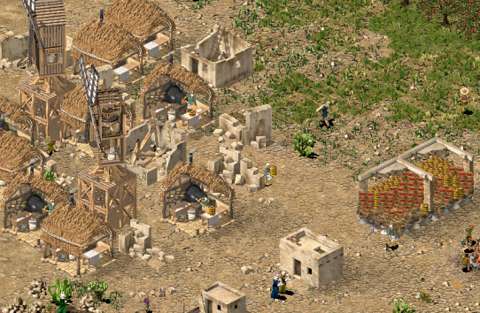
However, it has to be noted here that the peasants will always begin their new careers from the fireplace in front of the keep, regardless of whether they are labourers, artisans, tradesmen or arms-men.
This can become a problem, especially if the enemy has managed to penetrate the player’s defences to the front of the keep. Peasants who come out of the keep will still mill about the fireplace when this happens, regardless of the danger.
Of course, when this happens, the player has already lost.
PLACING BUILDINGS:
One of the ways in which the early Stronghold games differentiated themselves from their contemporaries is that buildings are constructed immediately when their foundations are placed. There is no need to rush workers over to them to build them.
This is not believable, but it is incredibly convenient. For example, when fighting against computer-controlled opponents, it is very easy to place cheap buildings in their way to bait them into attacking these, thus slowing down their advance.
“UNDO” AND “DELETE” BUILDINGS:
Like placing buildings, removing buildings is quite easy. This can be done in two ways.
The first way is very convenient. If the player has made a mistake in placing a building, the player can click on the “Undo” button in the user interface to reverse the mistake. Time is not recovered, but the resources which have been spent on the building are.
However, there is a “grace period” in which the player is allowed to do this. Once it is up, the “Undo” button will not do anything.
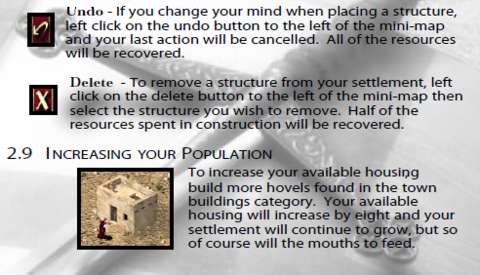
The other method is always available; the player can turn the mouse cursor into an instant-demolition tool. However, the cost for the buildings destroyed is only partially refunded.
HOUSES:
Like most real-time strategy games with medieval settings, the player increases the population of his/her subjects by building houses. These do little more than sit where they are, as to be expected of population-raising buildings.
However, their cheapness does allow for some cheesy tactics, such as placing them in the path of computer-controlled enemies.
An experienced player can also attempt a risky gambit by building many of these when he/she has high popularity, thus generating many peasants which can be quickly converted into troops. Of course, the player must have a lot of weapons and gold to support such a tactic.
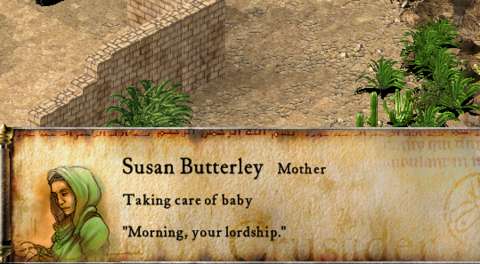
DIM WORKERS:
The peasants-turn-workers are completely out of the control of the player. They will pick their own paths between their workplace and whatever drop-off points which they use automatically – even if there are enemies in the way.
Of course, one can argue that their pathfinding is not too bad, though this is not due to any “intelligence” on their part; they cannot do anything more than pick the shortest paths (even if these bring them close to danger).
Rather, their pathfinding is aided by the convenient game design which is that their hitboxes are practically non-existent with regards to collision detection with objects in the environment. This means that the player will never find them wasting their time trying to negotiate terrain.
Unfortunately, they have absolutely no sense of self-preservation. If enemies are afoot, they are more than likely to just continue what they are doing and just die when they are attacked. That they die from just a single hit does not help either. In fact, it is a very viable tactic to raid an enemy’s economy because of their dim-wittedness.
DISABLING BUILDINGS:
If the player wants to free up peasants from a not-immediately important segment of his/her economy, he/she can click on one of the buildings which is associated with that segment and disable it – all of the same buildings will be disabled as well.
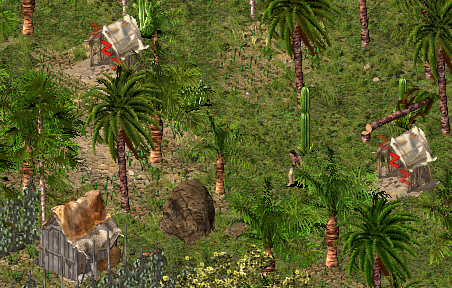
This can seem a bit overbearing. There does not seem to be any feature to disable individual buildings, unfortunately.
BUILDINGS ARE SQUARES:
An observant player may notice that almost every building which the player can place has a square foundation.
In terms of gameplay, this conveniently removes any need to get the best orientation in order to make use of limited space for building. However, there is a noticeable graphical issue with this design decision, as will be mentioned later.
FLEXIBLE DROP-OFFS:
Almost all resource-producing and resource-receiving buildings have drop-off locations. For example, Stone Quarries have pads nearby which the workers will place stones on.
Some other buildings have much more convenient drop-off points. For example, the Granary (which stores food) has drop-off points all around its perimeter, which is just as well because it is heavily used. The same can be said about the Stockpile.
This is perhaps one of the very few good design decisions on Firefly Studios’ part.
INFLEXIBLE GRANARY & STOCKPILE PLACEMENT:
One of Firefly Studios’ less-good design decisions is that it decided that Stockpiles can only be placed next to each other. The same can be said about Granaries.
The player does get to decide where to place the first Granary and first Stockpile, but that is it. The player must consider this placement carefully, in order to minimize the travel times of workers and the risk which they are subjected to.
There appears to be few, if any, ways to work around this limitation either. For example, wily players may attempt to extend and delete stockpiles such that a stockpile is closer to a cluster of logging camps, but the workers will usually attempt to fill up the original stockpile first, before making use of any stockpiles which are closer.
BLOCKING OFF BUILDINGS:
Although workers often have their hit-boxes waived and buildings have convenient drop-off points, buildings can be blocked off from approach if the player does not keep in mind that buildings do have hit-boxes where units do not.
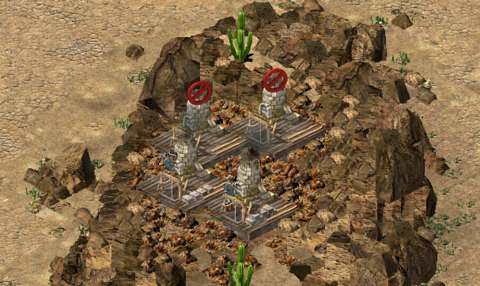
RESOURCES:
To say that the Stronghold series is pedantic for an RTS game is an understatement.
The game has several different categories of resources, and each category has multiple types of resources. The player will need each and every resource in order to have a town with the capability to raise armies.
Developing the resource chains can be a chore. In fact, it may have been more appropriate for a city-building game. (There is a game mode for this, as will be described later.)
Anyway, there is the “basic” category of resources. These are the fruits of the land, to use a metaphor. Wood is obtained from cutting down trees, crops are obtained from farms and minerals are obtained from deposits through mines.
However, not all of these basic resources are immediately usable. Wood, apples, stone and meat are usable right away, but they all come with caveats.
For example, the player can run out of wood if he/she runs an unsustainable wood-cutting operation. Apple farms are the cheapest farms, but they take the most space. Meat is only obtainable through hunting wild-life, which migrates frequently and can be rendered extinct from over-hunting. Stone, despite being a mineral, cannot run out, but stone-mining requires a lot of manpower.
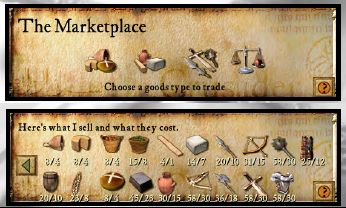
Most of the other basic resources often have to be processed into higher before they can do much of anything. For example, wheat does little until it has to be turned into flour, which also does little until it has been turned into bread. The same can also be said about hops.
The only exception is iron, which has a few uses in its ingot form – otherwise it is merely used as a raw material for the creation of weaponry.
All resources have to be stored somewhere before they are included in the player’s account. For example, (finished) food resources have to be stashed in the granary, whereas non-perishables are dumped in the (open-air) stockpile.
These storage places can indeed run out of room, thus requiring the extension of these places.
Indeed, the player can have one type of resource taking too much space in the stockpiles, such as wood from desperate attempts to clear out a fast-growing forest for farming space.
This is where the marketplace comes in handy. This building can be used to immediately trade off excess resources in return for gold. Of course, the marketplace does not exactly have the fairest of prices, as marketplaces in computer games are loath to have.
GOLD:
Speaking of which, gold is the only resource which does not need to be stored. The player can hoard as much gold as he/she likes; there can never be enough gold, though having ample gold also means that the player is not making good use of his/her assets, of course.
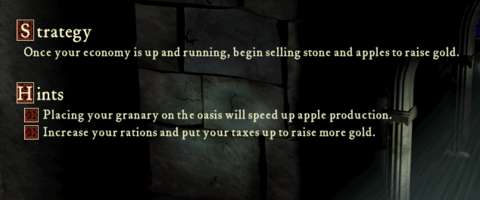
However, gold is not easy to obtain. There are certainly no gold deposits to mine the heck out of, for one.
Instead, gold has to be obtained through two means: the aforementioned marketplace (which is not always available in every scenario) and taxation.
Raising taxes always hits the player’s popularity rating. However, the player can attempt to juggle his/her popularity rating against gaining gold using taxation. There will be more on popularity shortly.
Anyway, gold is needed to purchase more advanced buildings and is needed to raise an army, especially an army which is composed of mercenaries.
POPULARITY:
The peasantry may be subservient to lords, but they can always choose to abandon their lords for others if the lords are not to their liking.
The player has to juggle a popularity rating, which determines how quickly peasants come out of the keep or how quickly they are abandoning the player.
This can be important, if the player needs to expand his/her economy or raise an army quickly. After all, there is only so much that ample resources can do if there is no one around to spend them on.
The threshold when the player starts to lose or gain peasants is 50; the rating cannot go above 100. Keeping this in mind can help meticulous players juggle popularities below the maximum while reaping the benefits of actions which reduce popularity.
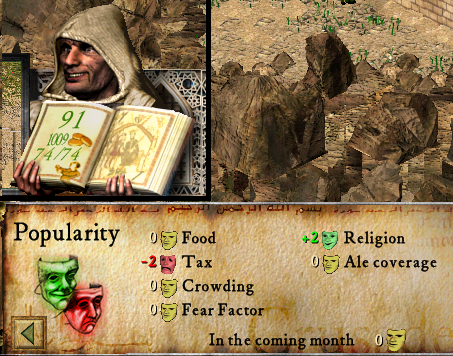
OASES:
A considerable difference which the Crusader spin-off has with the original Stronghold is that farms can only be placed on land which is considered fertile. Fertile land usually occurs next to oases. Trees can only re-grow on oases too.
This means that the player must manage the use of the space on fertile land carefully, specifically between farming and logging.
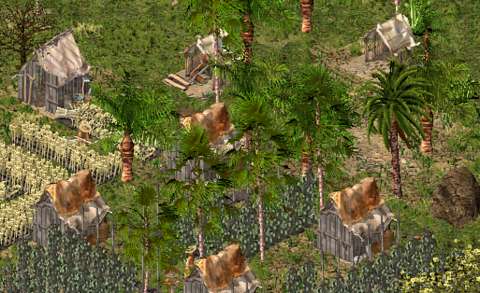
FIRES:
Economic buildings can catch on fire. The main cause of fire is enemies which use fire, such as the Arabian fire-throwers.
However, for better or worse, some scenarios come with random occurrences of fire – usually where the player has not made precautions for. The game seemingly picks locations within the player’s town to set on fire, usually where it is not protected by wells and fire-fighters.
When – not if – this happens, it can give the impression that the game is being fickle. Even if the player is lucky and fire does not happen anyway, he/she has wasted any assets which have been expended on fire-fighting capabilities and which could have been spent on more productive ventures instead.
Anyway, fires can be doused by application of at least two rounds of water-dumping by fire-fighters. This makes the standard well ineffective, because the single fire-fighter of the standard well will not be able to stop fires from spreading before he can make a second water-dump.
Interestingly, fires do not always appear to affect resource-storing buildings. They can be set on fire, and ostensibly the player should be losing resources as a consequence. However, the loss of resources does not always occur.
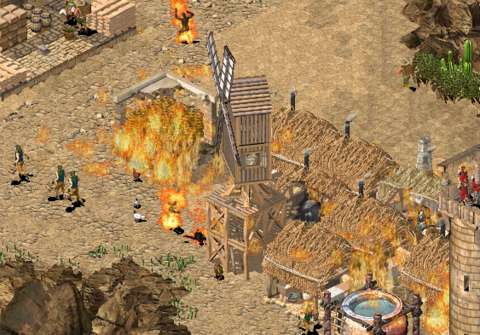
FOOD CONSUMPTION:
Food consumption is mainly a gameplay element which is associated with popularity.
If the player runs out of food, it will not mean that the player’s peasants start dying and troops start dropping dead. Instead, it means that the player’s popularity plummets.
Nevertheless, keeping food consumption at rates of full ration or higher is quite important; running out of popularity at an inopportune time can be unpleasant.
DEFENSES – IN GENERAL:
Economic buildings and peasants are very easy to destroy, so the player may want to build defences to protect them, or at least prevent raids.
Defences are mainly built with stone. There may be a lost opportunity here to allow the construction of wood-based defences.
Rotating the camera is especially important when building defences. One small mistake, e.g. a tiny gap in the corners of supposedly-connected walls, can cost the player the session.
Yet, the game could have made this tedious chore of rotating cameras unnecessary by conveniently connecting adjacent walls together anyway. (After all, Stronghold’s contemporaries, such as Age of Empires, and games like Black & White 2 have implemented such conveniences and are made better by these.)
There are also a lot of rules regarding defences.
Most of these are understandable, such as non-siege weapons not doing a damn thing on them. However, siege weapons do, but if the player is expecting them to be fielded by enemies, he/she can attempt to literally thicken walls if he/she has a surplus of stone. On the other hand, some siege weapons can fire over walls due to their projectile arcs, so walls will not delay all kinds of enemies.
There are also other esoteric ways of bringing down walls, such as sapping; some of these ways are hardly seen in other medieval RTS series. These will be described later together with military auxiliary units.
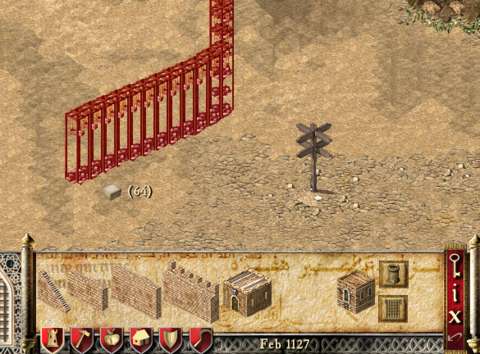
PLACING DEFENCES:
Perhaps the most important rules about defences are the restrictions on their placement.
Walls cannot be placed anywhere; they must be placed adjacent to existing walls, gatehouses or towers. Interestingly though, towers are exempt from this rule; they can be placed almost anywhere, except near sign-posts or within the vicinity of other lords’ keeps.
This means that wily players can attempt to claim whole swathes of territory early in a match. If he/she can gather the stone needed to pull this gambit, the player can plonk down a tower far from his/her keep and build walls which extend from it, just to surround patches of resources.
STAIRS, TOWERS & CRENELATED WALLS:
Stretches of walls will not be enough to protect the player’s holdings with. There are other kinds of (similarly stone-based) defences which can be used to augment the walls.
Chief of these are stairs. Without stairs, no soldiers can man the walls and prevent enemies from attempting to scale them. The other defences can only be accessed through getting onto the walls in the first place anyway, so stairs are always needed.
Stairs can be a bit finicky to place though, and if the player is not wise in planning ahead, the stairs can prevent the player from thickening the walls.
Then, there are towers and turrets. Ranged units such as archers can occupy them in order to gain additional protection, in addition to the obvious height advantage (which increases their range).
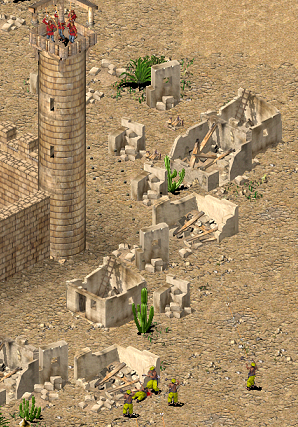
The most basic of these towers and turrets are just as vulnerable to sapping as walls are, but the more expensive and bigger ones are immune to sapping, thus making them powerful late-match defences.
Towers and turrets may not be satisfactory all the time, either due to cost or reliability concerns. Therefore, the player can add crenelated walls to existing walls, thus thickening the walls and adding battlements which can protect soldiers who are manning them from ranged attacks.
Crenelated walls do indeed provide direction-dependent protection. Careless players can learn the hard way that he/she has to provide crenelated walls to both sides of an existing wall if he/she is fending off attacks from all sides.
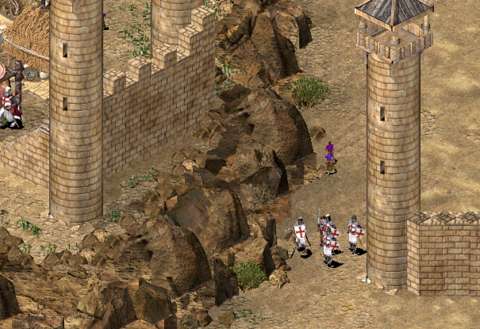
MILITARY ASSETS – IN GENERAL:
Interestingly, military units are not considered as part of the player’s population; if a player turns a peasant into a military unit, another peasant will replace that peasant.
Ostensibly, military units do not put a strain on food consumption either; however, replenishing an army as it suffers casualties does require a sizable economy and thus population.
They are also units which are well within the player’s control. However, they will always require gold to be recruited.
The game’s military units are divided into two overarching categories: Europeans and Arabians. The Europeans are further categorised into combat units and support units.
European combat units always require weaponry. Weaponry has to be created from facilities like the Fletcher’s Workshop and the Blacksmith, and then stashed at the Armory before the Barracks can be used to recruit military units. This means that players need to spend some time developing the economy which is needed to raise an army.
Early-match raids are still possible, but the player either needs to use his/her lord (which is very risky) or spend precious gold on expensive Arabian mercenaries. Speaking of which, Arabian mercenaries already come with their own gear, but they always cost more than their European counterparts. They also have some capabilities which will be mentioned later.
Support units are mainly meant for siege warfare (which will also be described later). They do not require weaponry, but they are next to worthless in direct combat.

The nuances – and foibles - of warfare in Stronghold Crusader will be described shortly.
WEAPONRY:
As mentioned earlier, European combat units require weaponry.
The nuance here is that after the player’s weapon-smiths have placed their products in the armory, the weaponry are considered as saleable goods. They sell for considerable amounts, if the player can accrue a lot of them (because marketplaces only buy and sell in bulk).
This is of course risky, if the player is fighting a battle of attrition with another lord. However, this optional endeavour is much appreciated (especially if the player needs Arabian mercenaries or siege weapons more than he/she does European soldiers).
ARMORED VERSUS UNARMORED:
At first glance, it would appear that armoured units merely have more hitpoints than unarmoured ones. However, their armor is an actual statistic which is taken into consideration when they take hits.
For example, Swordsmen can take a lot of arrow shots, far more than their hitpoints would suggest. However, if they walk into pitch-fires, they burn just as easily as unarmoured units.
Armor is also taken into consideration when close-combat occurs. Armor works better against certain close-combat weapons, such as the knives carried by slingers and archers, but not so well against swords and maces.
As an illustrative example, it is highly unlikely that any player can kill enemy lords efficiently without the use of swordsmen, especially when they are entrenched atop their keeps.
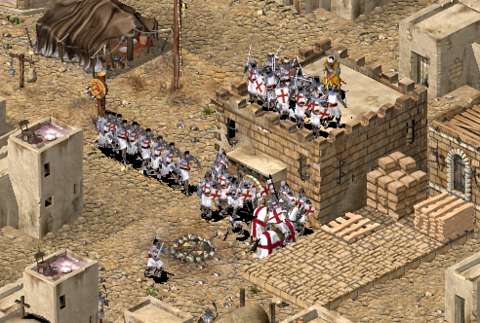
Armoured units are generally slower than their unarmoured compatriots. This can be seen when ordering both Spearmen and Swordsmen to move from point A to point B; the difference in speed is stark.
The only unit which voids this rule is the Knight. He is of course armored, but being mounted makes him faster than most other units. However, the player needs to raise horses, which are not cheap commodities (which have little other uses either) and Knights cannot do much against walls and towers.
ARABIAN MERCENARIES:
Arabian mercenaries are introduced in the Crusader spin-off series of Stronghold, apparently to fulfill the niche of units which only require the expenditure of gold to be recruited.
In scenarios which allow their use, the player can merely plonk down the mercenary camp very early in a match. The mercenaries are very useful for contingencies, such as defences against early-match raids. Alternatively, they are also useful for early-match raids. (Horse Archers, in particular, are very good for such tactics.)
Of course, this means that the player would be eating into his/her starting gold reserves, which could be conserved for more durable European combat units later on. After all, where they have counterparts, the Arabian mercenaries are noticeably weaker than the European combat units.
Yet, the Arabian mercenaries also have some very special units, such as the assassins. They are the only units which can scale walls, and they are also the only units which are invisible to opposing players while they are looking at the map.
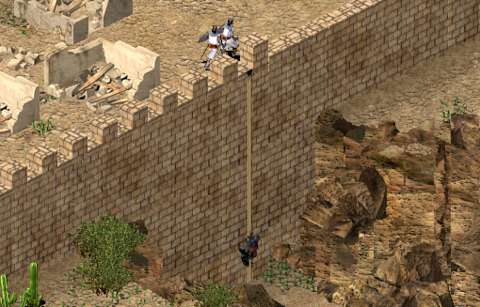
Arabian mercenaries are still converted over from peasants at the keep though, so the player might want to re-consider the distances which they have to move in order to reach a mustering point.
SIEGE WARFARE:
Many of the player’s opponents will erect walls and towers to defend themselves if the player cannot get them early. Some single-player scenarios also have enemies starting out with thick defences already.
Therefore, the player will need to field siege weapons. To do so, the player must field engineers, sappers or laddermen.
Laddermen are the least complicated of the three. As their names suggest, they carry ladders. Watching men running over to walls with overly long ladders can be amusing, assuming that the player is on the defence and his/her own forces on the walls are taking them down with arrows.
Otherwise, the player could probably do better with the other two specialists when the enemy has the wisdom to defend its walls with battlements and archers. (Learning that ladders can be knocked down the hard way is not fun either.)
Sappers are slow but reliable at topping defences. If there are no moats or large towers in the way when they dig, they tunnel under walls and lesser towers and collapse them by attacking their weak foundations. There are few ways to counter sappers when they have started their digs, but they are quite useless for anything else.
(Round towers apparently have foundations which are impervious to sapping.)
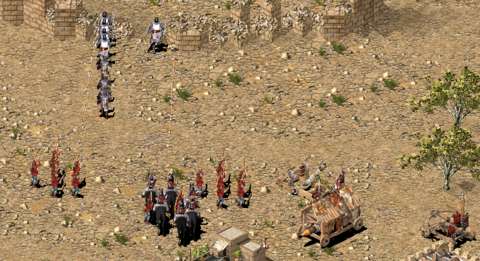
Engineers are the most useful of the three, mainly because they can be paid to build war machines. Amusingly, they can set up tents anywhere to build them, but they are incredibly vulnerable while doing so.
SIEGE GEAR:
As for the things which the engineers can build, they are rather varied.
There are simplistic objects like arrow shields, which are little more than logs which are tied together but are otherwise impervious to arrows (obviously). There are battering rams, which can be used on walls and towers in addition to gates (though they are most effective against gates).
Next, there are siege towers, which are more reliable than ladder-men but are bigger targets (and which can be set on fire too).
(It is worth noting here that walls which have been compromised by siege towers cannot be deleted, though the walls next to these walls can be deleted. This is cheesy, but it works against attempts by enemies to storm the walls in order to capture stairs and gatehouses. Of course, there would be holes in the walls by then, but if the player can micro-manage these cheesy tactics, e.g. filling the holes in at a convenient time, it can very much frustrate an opponent.)
Ballistae is the most accurate siege weapon (though “accurate” is a relative term here, because it is far from as accurate as, say, an arrow fired from a bow). They are powerful against slow-moving soldiers, such as swordsmen, but ballistae fall rather quickly when mobbed. Mangonels can be used against both units and buildings, but their terrible accuracy makes them unreliable (even despite their great number of projectiles).
Catapults and Trebuchets are best used against walls, if only because their terrible accuracy (especially the Trebuchets) makes them incapable of reliably hitting anything but stretches of walls. Even then, it may take a while for them to breach a wall, if only because they tend to miss the weakest part of a wall even though the player has directed them to do so. Catapults and Trebuchets also require the expenditure of Stone, namely as their ammunition.
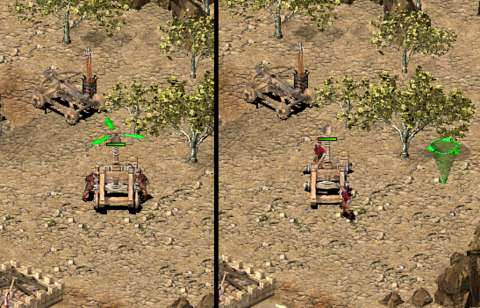
MOATS:
Moats are the most time-consuming defence to build. The player needs to reserve combat units which can dig for the moats instead of committing them for combat.
Digging can take a while, but moats which have been dug take a lot of time for enemies to counter. This is because a moat can only be countered by filling it in, or capturing a gatehouse with a drawbridge which spans the moat. This is, of course, not very safe to do when the enemies are on the other side of the moat firing arrows and other ordnance.
DAFT MILITARY UNITS:
One of the main problems about RTS games of Stronghold Crusader’s time is very stupid units which have little in the way of sophisticated behavioural scripts. Unfortunately, Stronghold Crusader – and its “HD” version – is no different.
Perhaps it could have been even worse, considering that the game had to resort to waiving the hit-boxes of units in order to compensate for their poor choices of paths.
Anyway, combat units have three types of stances which they can use when the player is not holding their hands. None of these stances are good, however.
By default, units will stand their ground. In the case of melee units, they will do nothing as they are peppered with arrows. The “Defensive” stance is not much different from the “Aggressive” stance; both practically allow the units to pursue enemies for certain distances, with “Aggressive” giving greater distances.
The problem here is that units do not act in groups when they are not being minded by the player. A few can always be lured away from the main group if they are using stances other than the default “Stand Ground”.
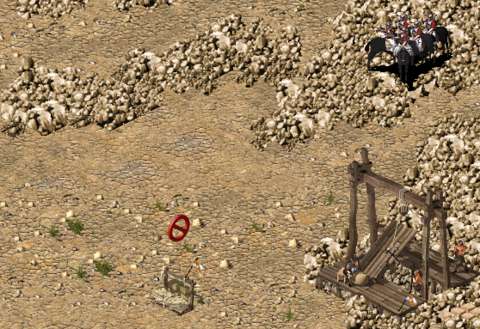
UNITS CANNOT HEAL:
Many of the game’s contemporaries in the RTS genre at the time gave the player some means to heal wounded units. That Stronghold Crusader does not have any can make it seem primitive. It may even seem incomplete, if one considers that defences can be repaired by spending stone to repair them (almost immediately, in fact).
Oddly enough, healing units are implemented in the later Stronghold games – such as Stronghold Crusader 2.
WILD-LIFE ATTACKS:
In some scenarios, the player may come under attack by hostile wild-life, such as lions; other players, including computer-controlled ones, can also be subjected to this seemingly random occurrence.
Scenarios with hostile wild-life attacks spawn them somewhere on the map, after which they travel towards any herd of prey wild-life – or in the absence of any which is near enough, towards the nearest human settlement.
Getting attacked by wild-life causes a popularity hit, in addition to the obvious slaughter of peasantry and military units alike. It can be unpleasant to suffer such a misfortune, especially if one considers that wild-life attacks are a matter of cruel chance.
HAPPINESS/FEAR FACTOR:
The final, and optional, element of building towns is placing structures which either make the populace happy or fearful. These options are mutually exclusive; structures which contribute to happiness will cancel out the contribution of structures which instill fear, and vice versa. Thus, flip-flopping will be a waste of resources.
Having a high happiness rating obviously increases the player’s popularity rating and imparts damage bonuses on combat units, but it results in loss of economic productivity. Conversely, having a high fear rating decreases the player’s popularity rating and inflicts damage penalties on combat units, but increases economic productivity.
This element of the game is perhaps best utilized early-match (e.g. having a high fear rating helps in building an economy) or late-match (e.g. having high happiness ratings will help when the player goes on the offensive), but this can take quite a lot of micro-management.
CAMPAIGNS:
The ‘story-based’ campaigns of Stronghold Crusader are trial-by-fire tutorials, as their in-game descriptions suggest. More experienced players would be able to do them without much problems, but any other player may be aghast at how difficult they are.
Firefly Studios does not exactly have a lot of good ideas on how to use the Crusades to deliver memorable gameplay and narrative. Most of these campaign scenarios start themselves off with some brief description of a scenario (reusing the same artwork every time) before telling the player what needs to be done.
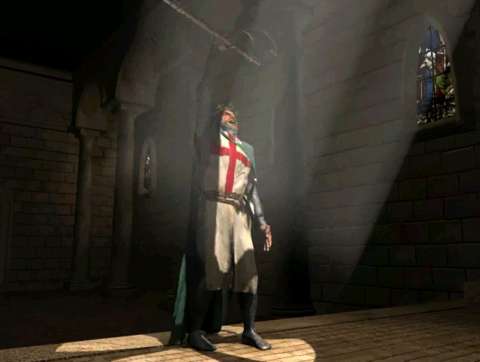
CRUSADER TRAIL:
There is the impression that Firefly Studios is not doing much with the settings of the Crusades beyond exploiting them to create virtual battles. This impression is bolstered by the single-player game mode which is the “Crusade Trail”.
On-paper, the “Crusade Trail” supposedly follows the advance of the Crusader forces into the Holy Land. However, there is no drama or story-telling to be had; the player is pitted against script constructs named after real, legendary, anecdotal or perhaps fictitious leaders of the crusades.
These script constructs have habits and preferences which can be exploited, if the player is observant enough to learn these.
Sometimes, the player is partnered with other script constructs, but with the caveat that the opposition is also at least equal in number.
Furthermore, the maps which the player start with are often not balanced. For example, the second scenario in the original Crusader Trail has the player starting out close to iron deposits but there are no stone deposits nearby, whereas the opponent – the “Scorpion” – has the opposite starting conditions.
The game mode increases the challenge of later scenarios by giving the computer-controlled opponents stronger lords (thus making the end-game more daunting) and more resources at the start of matches (thus the script constructs are able to execute their habits a lot earlier). These are artificial increases in difficulty.
(Granted, the later script constructs have nastier behaviours, but these are always observable enough to be countered.)
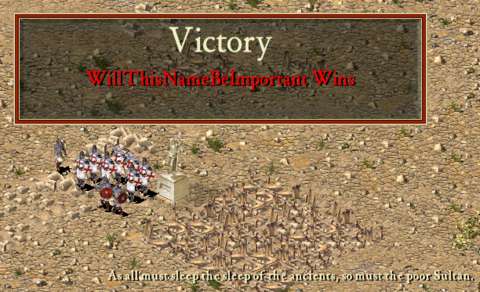
CASTLE-BUILDER:
As had been mentioned earlier, the game’s resource-chain system is better suited for city-building gameplay. Firefly Studios appears to be aware of this impression though, and it has implemented a city-building game mode.
In this mode, the player can play through maps which do not pit the player against another lord. However, there are signposts where raiders will spawn, so castle-building is certainly not a peaceful game mode.
MULTIPLAYER:
For better or worse, server listing and match-finding for Stronghold Crusader had been outsourced to GameSpy. After GameSpy went under, that went to GameRanger.
Fortunately, players do have the option of peer-to-peer connections, instead of being shoehorned into playing on proprietary servers. (Of course, this means that players have to deal with each other’s latencies.)
As for the gameplay in multiplayer, it is a simple affair; players fight against other players, either in teams or not. Victory conditions in multiplayer matches are mainly about the elimination of opposing lords and preservation of one’s own lord.
The main source of variation in the experience of multiplayer sessions comes from the maps. Not all of the maps are boringly symmetric; there are maps where players do not always start close to resources which they need. This can be a great test of a player’s skill – if he/she consents to playing such maps.
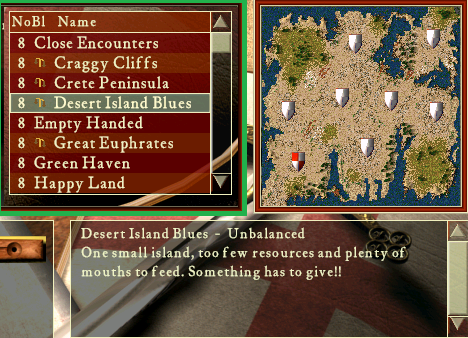
SCENARIO EDITOR:
At least Stronghold Crusader comes with a scenario editor. It is not particularly sophisticated, however; the most that the player could do is to create more maps for the game modes which have been described earlier.
VISUAL DESIGNS:
For a game which supposedly has the “HD” label, Stronghold Crusader will not have much eye-candy to offer anyone except die-hard fans of the series who want to see better-looking sprites for units.
Speaking of which, the sprites are made from 3D models whose animations had been captured and flattened into 2D images, not unlike what has been done for Space Colony HD.
The setting of the Crusades would have made the use of mainly dry and dusty terrain understandable. Yet, there can be only so much almond, bisque, beige, brown and other hues associated with the dry lands of the Middle East to see before the player has seen all there is to see. More learned people would know that the Crusades went through locales which are more than just this too.
As mentioned earlier, all buildings are squares. The player may notice that the same sprite is used regardless of the player’s reorientation of the camera. The only building to have different sprites when the camera is rotated is the Keep.
This can seem like laziness on the part of Firefly Studios, especially considering that this is supposed to be the “high-definition” version of Stronghold Crusader.
SOUND DESIGNS:
It has to be said first that most of the sound designs in Stronghold Crusaders would either sound annoying or stereotypical.
The annoying ones include repetitive reminders of what the player is doing, such as saving and loading games. Fortunately, some of these can be disabled.
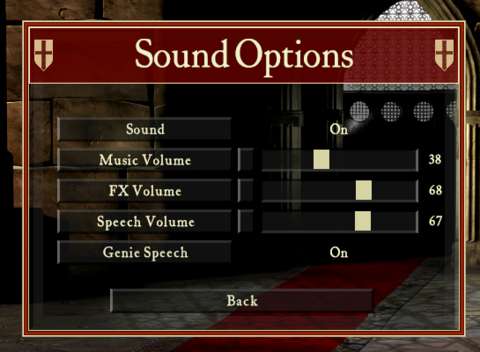
Then there is the voice-acting. Being known for games with tiresome character tropes like Space Colony, it should not be a surprise that all Firefly Studios would do with regards to Stronghold Crusader’s voice-overs is to provide hackneyed accents. There is little regard to historical facts such as the Crusaders’ different nationalities, e.g. just about every European sounds like a (not entirely authentic) Englishman.
Much of the same can also be said about the sound effects and music. Moreover, there are the sometimes grating sound effects which play out whenever the player selects a building, such as the characteristic but overly loud clang of hammers on steel when one selects the blacksmith building.
GLITCHES:
Unfortunately, Stronghold Crusader has not aged well in terms of compatibility with computers beyond 2002. Even though Firefly Studios revisited it for its “HD” version, it has not play-tested it thoroughly for potential problems. The problems which had been faced by this reviewer will be described shortly.
WAYPOINT PROBLEMS:
For whatever reason, the control inputs for setting waypoints cannot work immediately after having selected a group of units to give waypoints to.
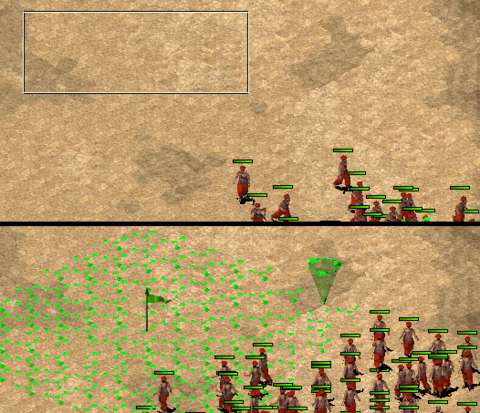
It is not clear whether the cause is due to incompatibility with OSes or issues with the mouse cursor, but it is clear that it does not happen to every player and it has never been addressed since 2005. (This is an example of a forum thread which mentions this problem).
SCREEN-CAPTURE:
By default, the button combination that is Alt+Q is supposed to create a screenshot of the current screen and saves it as a BMP file, which is stashed away in a certain directory on the player’s computer. Unfortunately, this screenshot may be corrupted and not viewable at all.
A viable work-around is to use the Print-Screen button and copy the result to the Clipboard, in the case of Windows OSes. However, this work-around would not have been needed if the built-in screenshot feature actually works.
GROUP ASSIGNMENT LOST WHEN ENTERING STRUCTURES:
One of the most aggravating glitch in the game is that group assignments for combat units can be lost when they are ordered to move onto defensive structures like towers and gatehouses. The player can use the numbered-group selection input to select units which are on the walls, but the ones in towers and gatehouses are omitted.
CONCLUSION:
It has been so many years on, but the “HD” remake of Stronghold Crusader has never addressed issues in its technical designs and had not refined the aging gameplay of the original. This is strictly for the die-hard fans of the Stronghold franchise who would swallow anything Firefly Studios churn out.
